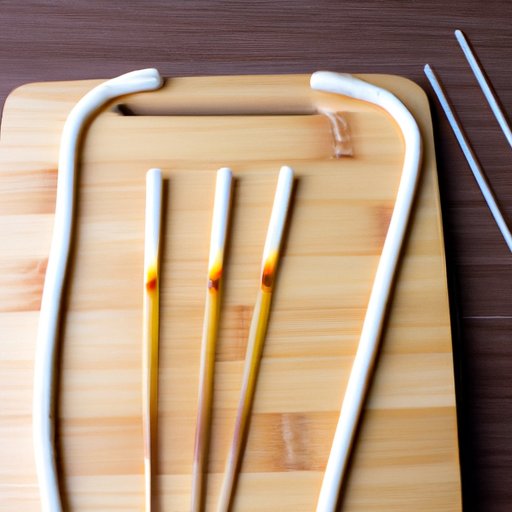Introduction
Ear candling, also known as ear coning or thermal-auricular therapy, is an ancient practice that has recently been gaining popularity as a natural remedy for various ailments. It involves inserting a hollow candle into the ear canal to create a vacuum that is thought to draw out built-up wax and debris. Proponents of the practice claim that it can provide relief from a range of conditions, such as tinnitus, sinus infections, headaches, and even hearing loss.

Explaining the Process of Ear Candling
The process of ear candling is relatively straightforward. A hollow candle is inserted into the ear canal, and then lit at the other end. As the candle burns, the heat and smoke created are thought to create a vacuum in the ear canal, which helps to draw out wax and debris. Once the candle has burned down, the wax and debris are collected and disposed of.
There are several different types of ear candles available on the market. These vary in size and shape, and some contain additional ingredients, such as herbs and essential oils, which are thought to enhance the effects of the treatment. It is important to select the right type of ear candle for your needs, as this can have an impact on the results.

Investigating the Benefits of Ear Candling
Proponents of ear candling claim that it can provide relief from a range of conditions, including tinnitus, sinus infections, headaches, and even hearing loss. However, there is limited scientific evidence to support these claims. One study published in the International Journal of Otorhinolaryngology found that ear candling had no effect on the amount of wax present in the ear canal, and concluded that “thermal-auricular therapy does not appear to be an effective method for removing cerumen from the external auditory canal.”
Despite the lack of scientific evidence, many people claim to have experienced positive results from ear candling. Some report a decrease in symptoms, such as tinnitus and headaches, while others report an improved sense of smell and hearing. While the efficacy of ear candling is still debatable, it is clear that the practice has helped some people find relief from their symptoms.
Examining the Controversy Surrounding Ear Candling
Although ear candling is becoming increasingly popular, there is still a great deal of controversy surrounding the practice. Many doctors and healthcare professionals have expressed concerns about the potential risks and complications associated with ear candling, such as perforation of the eardrum, infection, and even burns.
In addition, there are a number of misconceptions about ear candling that need to be debunked. For example, some people believe that ear candling can draw out toxins from the body, however, this is not the case. Ear candling does not remove toxins from the body, and any perceived benefits are likely due to the placebo effect.
Understanding How to Prepare for an Ear Candling Session
If you are considering ear candling, it is important to determine if it is right for you. Speak to your doctor or healthcare provider to discuss the potential benefits and risks of ear candling, and whether it is suitable for your individual needs. If you decide to proceed with the treatment, make sure to select the right type of ear candle for your needs.
It is also important to take the necessary precautions before and during an ear candling session. Make sure to read all instructions carefully, and follow all safety guidelines provided by the manufacturer. It is also advisable to seek professional supervision, as this can minimize the risk of any adverse effects.

Evaluating the Safety of Ear Candling
Although ear candling is generally considered safe when performed correctly, there are some potential adverse effects that should be taken into consideration. These include irritation of the ear canal, burns, infection, and even perforation of the eardrum. To minimize the risk of any adverse effects, it is important to ensure that the procedure is carried out by a qualified practitioner, and that all safety guidelines are followed.
It is also important to remember that ear candling is not a substitute for medical treatment. If you experience any symptoms or discomfort after the procedure, it is important to seek medical advice immediately.
Analyzing the Results of Ear Candling Treatments
The results of ear candling treatments vary from person to person. Some people report an immediate improvement in their symptoms, while others may not experience any changes until several days after the procedure. In general, most people report a reduction in symptoms, such as tinnitus and headaches.
As with any alternative therapy, it is important to assess the overall effectiveness of ear candling over time. Keep track of your progress, and speak to your doctor or healthcare provider if you are concerned about any changes in your symptoms.
Conclusion
Ear candling is an ancient practice that has recently been gaining popularity as a natural remedy for various ailments. The process involves inserting a hollow candle into the ear canal to create a vacuum that is thought to draw out built-up wax and debris. Although some people claim to have experienced positive results from ear candling, there is limited scientific evidence to support these claims. It is important to understand the potential risks and benefits of ear candling, and to take the necessary precautions to ensure it is performed safely.
Overall, ear candling is a safe and potentially beneficial practice, but it is important to weigh up the pros and cons before deciding if it is right for you. Ultimately, it is important to remember that ear candling should not be used as a substitute for medical treatment, and that any changes in symptoms should be discussed with a healthcare professional.
(Note: Is this article not meeting your expectations? Do you have knowledge or insights to share? Unlock new opportunities and expand your reach by joining our authors team. Click Registration to join us and share your expertise with our readers.)
